How to decorate with indoor plants – latest trends
Recent studies have shown that when you decorate with indoor plants, it offers some of the benefits of being outside. So I visited an exhibition at the Leman Locke apartment hotel in Shoreditch to pick up new ideas.
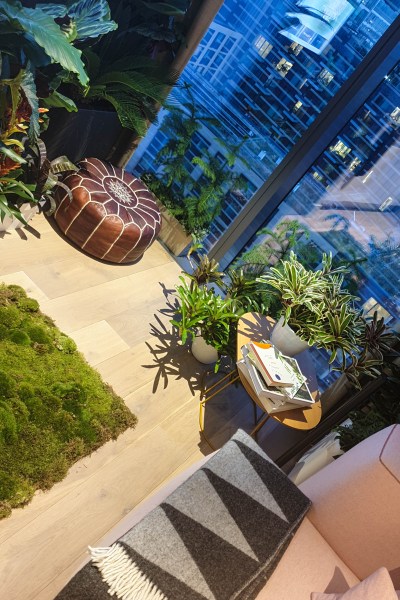
One of the Leman Locke hotel apartments decorated with plants by Michael Perry, Mr Plant Geek.
Three top plant people each decorated a small apartment with houseplants. And indoor garden designer Ian Drummond, creative director of Indoor Garden Design, created a houseplant ‘installation’ in the Leman Locke restaurant to showcase new trends in displaying indoor plants.
Plonking a spider plant on the windowsill doesn’t quite say ‘decorate with indoor plants’ any more! Personally, I blame Instagram. Once you’ve scrolled through a dozen images of lush indoor jungles, it’s hard not to start dreaming of cascading greenery and stylish pots.
But there’s also some serious science associating health and well-being with indoor plants.
Michael Perry (Mr Plant Geek), Nik Southern of Grace & Thorn florist and Oliver Heath, architect specialising in biophilic design, all designed one apartment each.
The project was created by The Joy of Plants, the plant information site run by the Dutch Flower Council.
Note: links to Amazon are affiliate, see disclosure. As an Amazon Associate I earn from qualifying purchases. Other links are not affiliate.
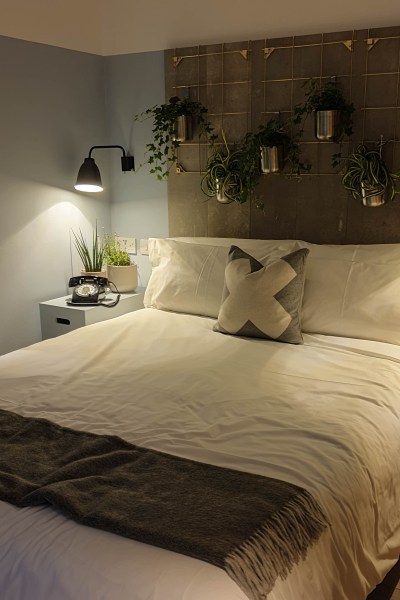
How to decorate with indoor plants in the bedroom – Oliver Heath used a grid on the wall above the bed.
Why decorate with indoor plants?
The Global Impact of Biophilic Design in the Workplace study found that people who work in buildings with plants reported 15% higher levels of well-being, according to Joy of Plants.
And people expressed improved feelings of well-being and creativity, too.
So what is biophilic design?
Biophilia means ‘love of nature’. Biophilic design means incorporating natural elements into the built environment to make life easier or more enjoyable for the people who live and work in the buildings.
Studies have shown that plants can reduce stress or improve sleep or concentration. It’s also been shown that patients in hospitals respond well to living greenery in their environment or hospital gardens. The science of plants and well-being has some way to go but there are promising early results.
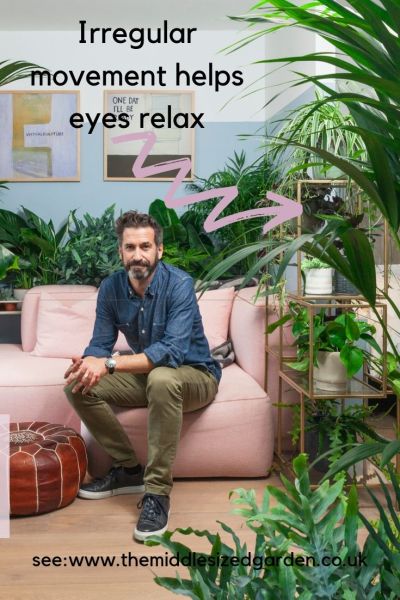
Oliver Heath in the apartment he decorated with plants. He includes fine, frondy leaves which don’t cut out the light. They move gently with the air, giving eyes an opportunity to re-focus and relax.
For example, Oliver Heath says that non-rhythmic movement – such as the fronds of a plant waving in the breeze – has been show to allow eyes to adjust and re-focus. This helps reduce eye-strain and its associated fatigue and headaches. So seeing the natural movement of plants can help you relax and focus.
Where to put plants in the home?
When you start to decorate with indoor plants, you must consider where the plants are going to go, says Ian Drummond. ‘Start with the environment. Is the room shady or draughty? What are the light levels?’
He suggests you think about what the conditions are in your room, then research which plants will fit. And you could also do it the other way round. If you’ve fallen in love with a house plant, look it up when you get home to find where it will flourish in your home.
Ian says that the descriptions on the plant labels probably won’t provide enough information, so you’ll need to go online to find out a bit more about the best place for your plant.
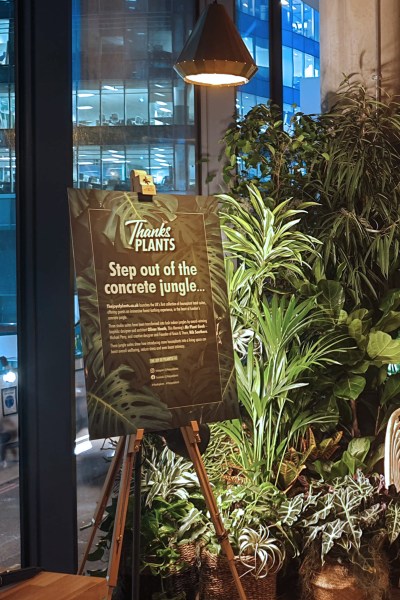
Ian Drummond designed a ‘houseplant installation’ – a big grouping of house plants as a focus in one corner of the Leman Locke restaurant. The concrete jungle is just outside the window!
If you’re short of space, both outside and indoors, consider plants you can enjoy as house plants in the winter then move outside onto a terrace or patio in the summer. Find out about indoor outdoor plants here.
How to arrange indoor plants
Ian Drummond suggests that you arrange a grouping of indoor plants along the same principles as you arrange outdoor plants. ‘Place the larger plants at the back, for example. Think about contrasting the foliage. And bring in some variegation in the leaves to add light.’
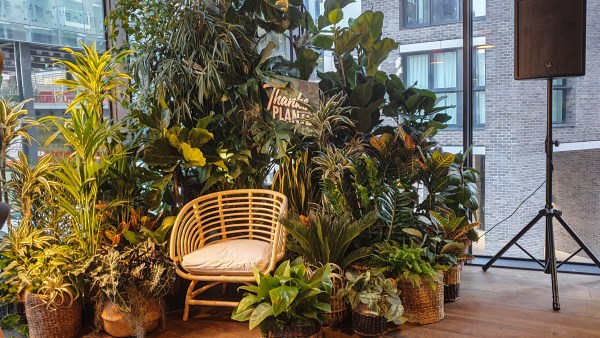
A wider view of the house plant ‘installation’ by Ian Drummond in the corner of the Leman Locke restaurant. Ian suggests a display like this to create a party feel.
‘Right plant, right place’ is a saying used outside in the garden. It means that if you put the plant in the right situation, so it gets the right amount of rain, sunlight or drainage, then it will thrive. Alice and Maddie Bailey of the indoor plant shop, Forest, have taken this philosophy indoors with their book The Green Indoors. It explains how to understand the way your house plant would grow outside in its natural habitat. And that helps you know where to put it in the house.
Plant decor in the bathroom
Do you fancy filling a tiny windowless shower room with plants? Mr Plant Geek did it at the Leman Locke without taking up any floor space and leaving you plenty of room to shower.
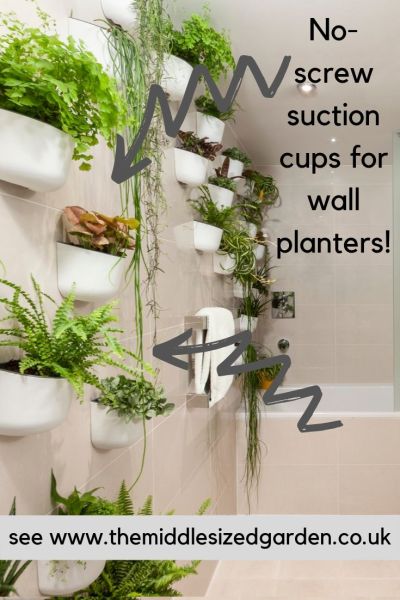
Michael Perry used suction cups for these plant holders and was able to fill this tiny bathroom with plants. He’s chosen plants that do well in low light, but you would still need either to install a grow light or swap the plants around into the light on a regular basis. Find more of Michael’s creative ideas and new plants in his Mr PlantGeek newsletter.
He used suction cups so that he could create a living wall without any drilling. And he filled the pots with cheap, easy-to-grow small plants, such as helxine. Its common name is – delightfully – Mind-Your-Own-Business.
Suction cups do usually fall off eventually – although these seemed very strong. But plants are small and light, so they’re unlikely to do any damage….
And you could adapt this idea with suction bathroom accessories, such as this white plastic toothbrush mug holder that attaches by suction. Or use a shower caddy to hold two small plants.
Or create a living wall with a grid
If you want lots of plants on the wall but don’t want to screw lots of holes in it or use suction, then a wire rack or grid is a practical option. Nik Southern had a copper grid made for the living room in her Leman Locke apartment.
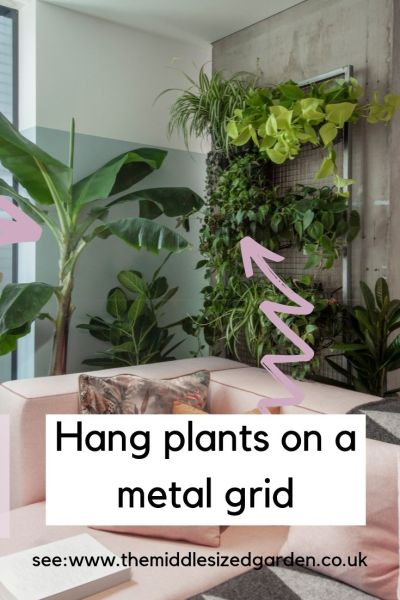
Nik Southern had a copper grid made for this living room wall. The plants hang from hooks and can easily be rearranged when you buy a new plant or a plant dies.
Grids are relatively easy to source. I found Oucles Photo Wall Grid set and the black metal Wall Hanging Panel Grid, which were both ‘Amazon Choice’ products.
You could also buy wire mesh fencing panels cheaply, either on Amazon, look online or go to a local hardware supplier. Or for a smaller grid, you could consider a heavy-duty plastic filter grids, such as the Aquacadabra Square Cut Filter Grid.
Decorating your home with indoor plants
All the designers emphasised that these indoor plant displays were temporary – more of an artistic ‘installation’ than a permanent design. They are to inspire you and give you ideas you can adapt when you decorate with indoor plants. They were only at the Leman Locke for around a month.
Because there are practicalities to consider. Houseplants need more care than plants in the garden because they’re completely dependent on you for their water. Outside, you can leave plants untended and many will just grow.
Inside, you’ll need to water but not over-water. If you have a row of plants on a high shelf or the top of a wardrobe, you’ll need to get up there to water once a week.
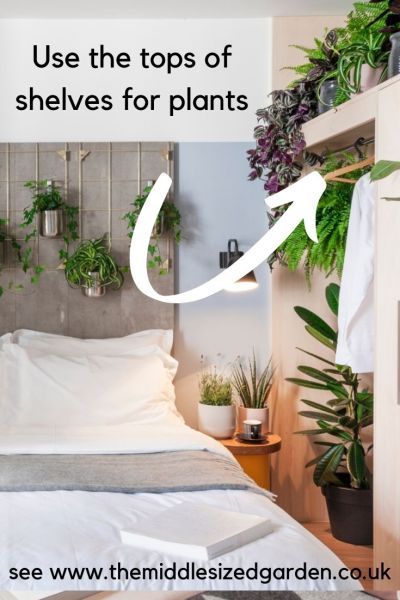
Oliver Heath used the top of a wardrobe shelf for a row of plants. The two issues to remember here are light and water. If the shelf or cupboard top is in a light place and you water once a week,this could be a brilliant place for plants. Or you could install a grow light above them.
Consider how much light the plant needs
You’ll need to find out which plants are best for low light conditions, such as the tops of wardrobes or the backs of rooms. And which plants prefer a bright, sunny spot.
Where light levels are low, you can buy ‘grow lights’ to help plants grow in artificial full spectrum wavelengths. The Amazon Choice Grow Light Bar for Indoor Plants can be stuck or screwed to surfaces and has a timer so you wouldn’t need to switch it off when you go to bed.
Or you can get grow lights in a lamp form, such as the Kingbo LED Grow Light twin goose-neck lamp.
More fun decorating ideas with indoor plants
Some of the indoor plant decorating ideas were about fun, not about being practical. Michael Perry’s living moss rug was a real talking point. And you can run your bare toes over it…
He worked with a Norwich company called Scaped Nature to create the rug. It’s made of two different kinds of moss on a grid mat. It needs a spritz of water every day.
Scaped Nature specialise in plants and plant design for aquarium and terrarium planting. They have plants, designs, books and workshops – ideal for those who want to decorate with indoor plants in an unusual way.
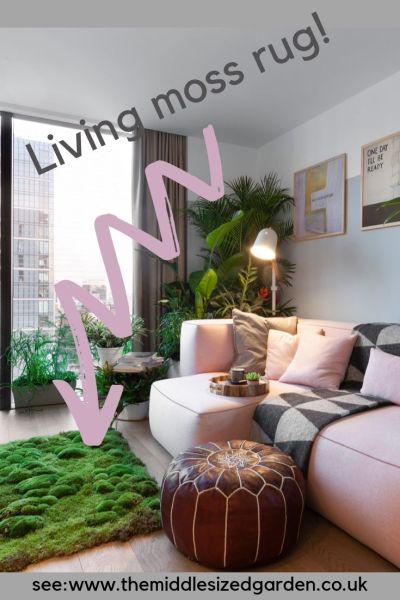
Michael Perry created this living ‘moss rug’. It’s not going to withstand much wear, but it’s a great idea to get us thinking about plants in a different way!
Glue airplants for special effects
Another fun idea from Michael Perry is sea shells with air plants hanging out of them. These are actually quite do-able – and they’d be great for a seaside house. Airplants (Tillandsia) like bright, filtered light so they wouldn’t want to be in an unlit bathroom for long, unless there was a grow light fitted. But this could look wonderful in any room with enough light.
Tillandsia can be glued to the shell with a drop of waterproof or cooled hot glue (not superglue). They need total immersion in water every week or so, but need to dry out completely after that. They should be fed with a bromeliad fertiliser spray, such as Houseplant Myst. Look up the exact instructions for your tillandsia but it’ll probably need spray fertilising around twice a month.
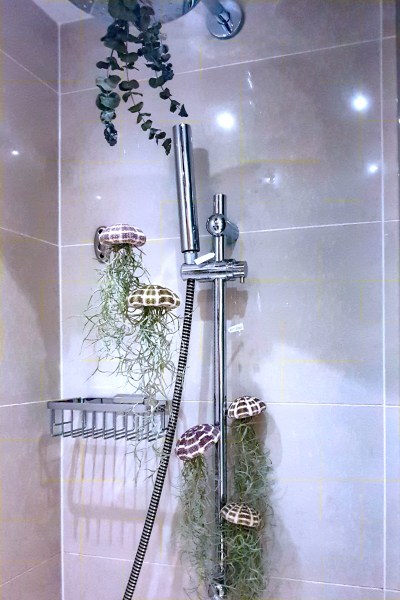
Michael Perry’s fun Tillandsia plants in sea shells. And the eucalyptus twigs hanging from the shower head add an exhilarating element to the shower water.
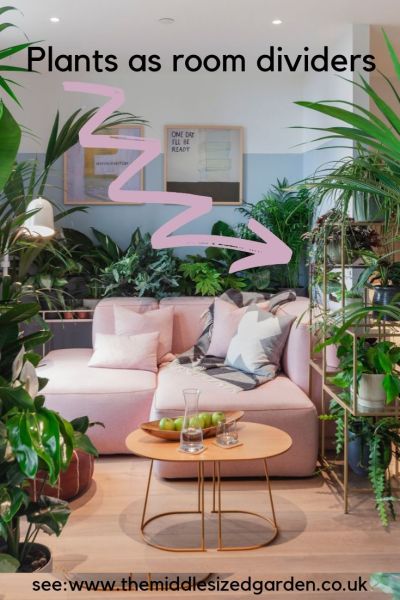
Oliver Heath suggests using plants as room dividers. They won’t block the light and you’ll get the health benefits.
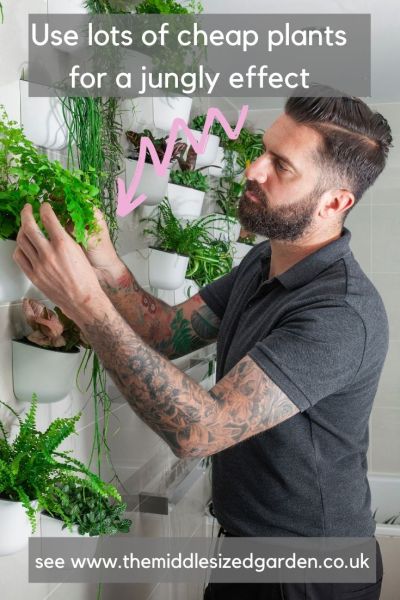
Michael Perry used lots of what he calls ‘tot’ plants – common easy-carehouseplants you can buy cheaply. Use lots of them to create a jungly effect.
Plant decor in the bedroom
Nik Southern of Grace & Thorn created a romantic bower of hanging plants over the bed.
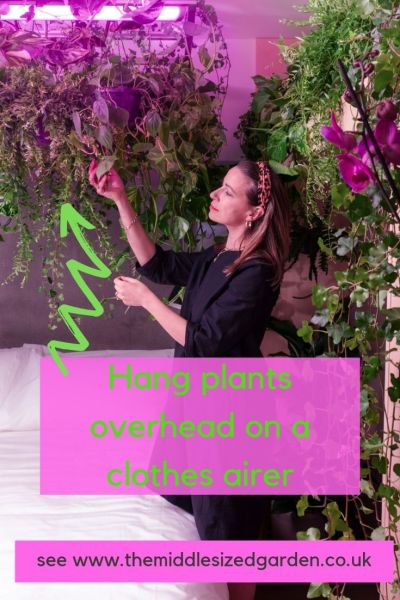
Nik Southern making last minute adjustments to the hanging plant canopy over the bed.
Nik suggests that you could re-create this look by using a hanging clothes airer.
They’re available in contemporary (Hangerworld 26 peg aluminium) and traditional styles (Ironmongery World traditional clothes dryer). You’d then need to be quite handy in how you secured the plant pots to the dryer.
‘Also make sure you choose the right planters that will prevent water leaking below,’ advises Nik.
Nik says that you shouldn’t worry about your indoor plants too much. If there’s a broken or dead leaf, just snip it out.
If the leaves turn yellow or brown, then you’re either over-watering or under-watering. And if your plant isn’t really growing, then it’s probably not getting enough light. But you might not mind it not growing!
Pots for indoor plants
Pots for indoor plants need to be water-tight. You don’t want water dribbling down over your surfaces and floors.
But indoor plants need drainage. The easiest way is to pop the indoor plant, in the pot you bought it in, straight into the indoor planter. You can then switch it round easily, and even take it out for watering.
The easiest way of watering house plants is to lift all the pots out and give them all a good soaking in the sink once a week. Then let them drain before putting them back into the ornamental containers. But different house plants need different amounts of water.
I’ve found Elho planters, which can be used indoors and outside, to be of good quality. And Michael Perry used Elho planters on wheels for his grouping of plants – very useful if you need to move the plants aside quickly.
I also love the 1970s style planters from Plant Furniture. They fit into both vintage and contemporary style and are well made. Here are some more inspiring indoor plant pot ideas.
But don’t bring terracotta pots from the garden into the house unless you stand them on a saucer. Terracotta absorbs water, so you may get a watery mark on your painted or wooden surfaces where the pot has stood.
Check out the video
You can see more angles and views of the way the houseplants are displayed in the video that goes with this blog post.
More help on how to decorate with indoor plants
Ian Drummond has written At Home With Plants, a book based on ‘all the questions people ask me about choosing indoor plants’. It has lots of ideas for displaying house plants.
And Nik Southern’s book How Not To Kill Your Plants is also very useful for anyone venturing into keeping houseplants.
Michael Perry runs the fascinating Mr Plant Geek newsletter about plants as well as The Plant Based Podcast. Both are always a good source of plant news. He runs the podcast with Ellen Mary, who has a Gardening Wellbeing studio on her website to help people connect with plants to improve their physical and mental well-being.
And I regularly turn to The RHS’s Practical House Plant Book. It’s a very useful and attractive book with 175 ‘plant profiles’ to help you look after your houseplants. Plus there are ideas on displaying indoor plants.
And if you prefer to find out information via a podcast, Jane Perrone’s On the Ledge podcast is all about indoor gardening. It’s a pleasure to listen to. See here for more about garden podcasts.
And check out the Middlesized Garden sustainable t-shirts, hoodies and tote bags
If, like me, you try to garden in a sustainable and wildlife friendly way, then you may be interested in the hoodies, t-shirts and tote bags on the Middlesized Garden Teemill store. They’re made of natural materials, using renewable energy and delivered in plastic free packaging.
Pin to remember how to decorate with indoor plants
And do join the Middlesized Garden blog for a free weekly email with tips, ideas and inspiration for your garden.
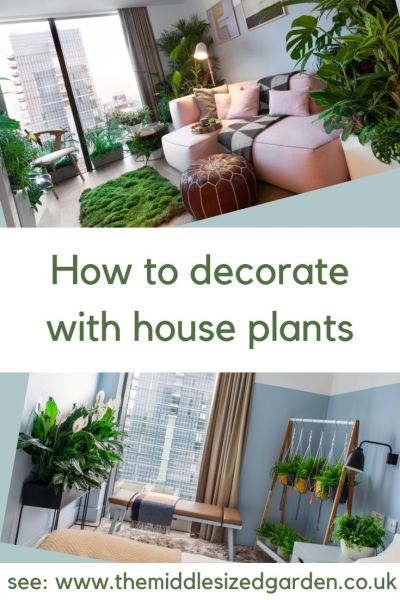
























Brilliant house plants and we should all be enjoying more of them. Look out for the yellow book next year and the first house plant collection to open for the National Garden Scheme, best of all it is in Kent.
Great, thanks for the tip. Will look out for it!